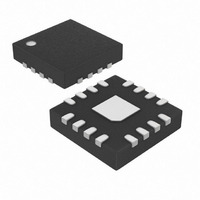MAX6947ATE+T Maxim Integrated Products, MAX6947ATE+T Datasheet - Page 19

MAX6947ATE+T
Manufacturer Part Number
MAX6947ATE+T
Description
IC LED DRIVER LINEAR 16-TQFN
Manufacturer
Maxim Integrated Products
Type
Linear (I²C Interface)r
Datasheet
1.MAX6947ATE.pdf
(24 pages)
Specifications of MAX6947ATE+T
Constant Current
Yes
Topology
Open Drain, PWM
Number Of Outputs
10
Internal Driver
Yes
Type - Primary
Backlight
Type - Secondary
RGB, White LED
Frequency
400kHz
Voltage - Supply
2.25 V ~ 3.6 V
Voltage - Output
7V
Mounting Type
Surface Mount
Package / Case
16-TQFN Exposed Pad
Operating Temperature
-40°C ~ 125°C
Current - Output / Channel
20mA
Internal Switch(s)
Yes
Number Of Segments
3
Low Level Output Current
21.12 mA
Operating Supply Voltage
2.25 V to 3.6 V
Maximum Supply Current
60 uA
Maximum Power Dissipation
1176 mW
Maximum Operating Temperature
+ 125 C
Mounting Style
SMD/SMT
Minimum Operating Temperature
- 40 C
Lead Free Status / RoHS Status
Lead free / RoHS Compliant
Efficiency
-
Lead Free Status / Rohs Status
Details
The RST, SCL, and AD0 inputs and SDA remain high
impedance with up to +6V asserted on them when the
MAX6946/MAX6947 power down (V
P0 to P9 remain high impedance with up to +8V asserted
on them when the MAX6946/MAX6947 power down. Use
the MAX6946/MAX6947 in hot-swap applications.
The MAX6946 features the OSC input, allowing the
device to use an external clock as the PWM clock
source. The MAX6946 features a fixed I
address of 0100000. The MAX6947 features an AD0
input, allowing two unique I
The MAX6947 always uses the internal 32kHz oscillator
as the PWM clock source.
The MAX6946/MAX6947 correctly regulate the con-
stant-current outputs, provided there is a minimum volt-
age drop across the port output. This port output
voltage is the difference between the load (typically
LED) supply and the load voltage drop (LED forward
voltage). If the LED supply drops so that the minimum
port output voltage is not maintained, the driver output
stages brownout and the load current falls. The mini-
mum port voltage is approximately 0.5V at 10mA sink
current and approximately 1V at 20mA sink current.
Operating the LEDs directly from a battery supply can
cause brownouts. For example, the LED supply voltage
is a single rechargeable lithium-ion battery with a maxi-
mum terminal voltage of 4.2V on charge, 3.4V to 3.7V
Figure 15. LED Brownout
10-Port, Constant-Current LED Driver and
3.05
3.00
2.95
2.90
2.85
2.80
2.75
2.70
2.65
2.60
2.55
2.50
I/O Expander with PWM Intensity Control
______________________________________________________________________________________
the MAX6946 and MAX6947
Driving LEDs into Brownout
2.5
3.0
3.5 4.0 4.5
V
Differences Between
LED
2
C addresses (Table 10).
V
vs. V
LED
SUPPLY (V)
LED
DD
5.0 5.5
Hot Insertion
SUPPLY
= 0V). I/O ports
6.0
2
C slave
6.5
7.0
most of the time, and down to 3V when discharged. In
this scenario, the LED supply falls significantly below
the brownout point when the battery is at end-of-life
voltage (3V).
Figure 15 shows the typical current sink by a LITEON
LTST-C170TBKT 3.0V blue LED as the LED supply volt-
age is varied from 2.5V to 7V. The LED currents shown
are for ports programmed for 10mA and 20mA constant
current, swept over a 2.5V to 7V LED supply voltage
range. It can be seen that the LED forward voltage falls
with current, allowing the LED current to fall gracefully,
not abruptly, in brownout. In practice, the LED current
drops to 6mA to 7mA at a 3V LED supply voltage, this
is acceptable performance at end-of-life in many back-
light applications.
The open-drain output architecture allows the ports to
level translate the outputs to higher or lower voltages
than the MAX6946/MAX6947 supply. Use an external
pullup resistor on any output to convert the high-imped-
ance, logic-high condition to a positive voltage level.
Connect the resistor to any voltage up to 7V. When
using a pullup on a constant-current output, select the
resistor value to sink no more than a few hundred
micramps in logic-low condition. This ensures that the
current sink output saturates close to GND. For inter-
facing CMOS inputs, a pullup resistor value of 220kΩ is
a good starting point. Use a lower resistance to
improve noise immunity in applications where power
consumption is less critical, or where a faster rise time
is needed for a given capacitive load.
20
18
16
14
12
10
8
6
4
2
0
2.5
3.0
3.5 4.0 4.5
I
LED
V
vs. V
LED
SUPPLY (V)
LED
5.0 5.5
SUPPLY
Output-Level Translation
6.0
6.5
7.0
19











